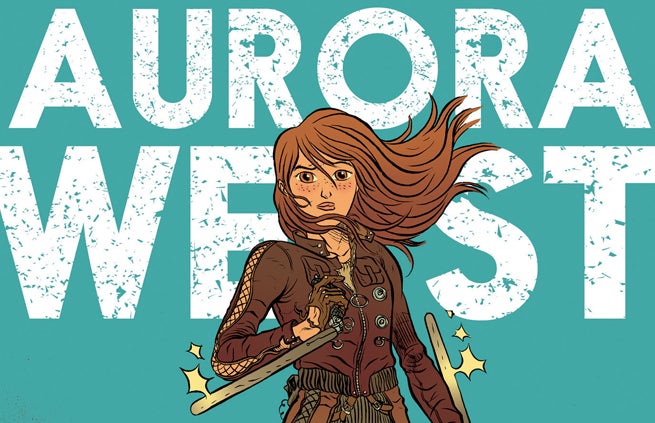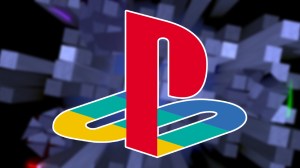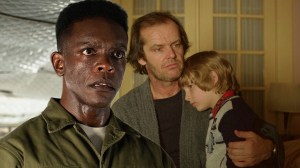
Kids need thoughtful comics, too. It’s an idea that’s dominated the mind of celebrated comics creator Paul Pope. His first stab at creating a rich and age-appropriate world, Battling Boy, met critical praise from Wednesday Warriors and school librarians alike upon its release last year. Pope showed that with enough imagination and charm, any generation could enjoy graphic novels.
Videos by ComicBook.com
The writer and illustrator proves that point again with The Rise of Aurora West, his next installment into the world of colorful demi-gods and pulp action heroes. Set before the events of Battling Boy, this companion series chronicles the titular heroine’s unusual upbringing while also delving deeper into the realms of monsters, mortals, and Gods. Pope has an entire universe mapped out, which we was more than happy to chart with ComicBook.com Here, he explains where Aurora West fits within the greater Battling Boy saga, the process of incorporating mature themes into children’s comics, and how kids can relate to the character of Aurora West. But much like Pope’s work, there’s something here for readers in every age bracket.
Thanks for taking the time to chat, Paul. “The Rise of Aurora West” looks like it has that same kinetic energy you established in “Battling Boy.”
It’s exciting. it’s the first time I’ve written a graphic novel for another artist. I’ve drawn stuff that other people have written, but this is the first time I’ve really undertaken a 400-page story like this. I’m collaborating with J.T. Petty on it, which is working out really well. He’s a really smart guy, and I enjoy working with him a lot.
For those who haven’t heard much about the book yet, can you explain general theme and thesis of The Rise of Aurora West?
It’s not really a prequel; it’s more of a companion story. Well, it is a prequel in the sense that it leads up to Battling Boy. Aurora’s book ends pretty much where Battling Boy’s begins. It’s sort of like how Pink Floyd’s The Dark Side of the Moon is designed so that you can listen to it on a continual loop. The first note you hear and the last note you hear are the same.
This one is very different from Battling Boy. It’s a lot more psychological, and it follows Auroras’ story basically since she was a child. Battling Boy is more of a big opera, like Wagner’s Das Rheingold. Aurora’s story is more psychological; it deals with the West family. In Battling Boy, we don’t know the names of the parents, or Battling Boy’s, because they’re gods. I felt like these characters should be remote, up on their mountain, whereas with Aurora, we go into her house and see her parents. We see them develop, and we see the fall of the family, the tragedy. In a Shakespearean sense, we define the tragic hero as the one who is blind to his worst faults, which leads to the downfall. I like that, so I wanted this book to have more of that somber tone.
As I was working on all of these characters, I came up with a back-story for the West family. Aurora also plays a big part of Battling Boy 2, which is what I’m writing and drawing right now. There isn’t a lot of room in the Battling Boy series to give Aurora center stage, because Battling Boy is the center stage. She’s more the foil, the moon to his sun. This is a chance to roll up the sleeves and get into hardcore pulp fiction material, something more akin to Doc Savage or some of the old Universal serials from the thirties and forties like Flash Gordon.
Awesome. So, was it always your plan to start the Aurora companion series before the next Battling Boy entry? Was the universe supposed to unfold in this order, or did things just fall out this way?
It’s a little bit of both, because we’ve been working on this Aurora series the entire we’ve been working on Battling Boy. We just didn’t announce it. I think J.T. and I had the script done just after 2012, and then we had to find the artist. Luckily, David was available, so he was able to move into the book pretty quickly. And then in my case, it’s difficult to write and draw a graphic novel, and then promote it. I’m at my studio two weeks a month now. It just worked out to be a good plan, because the two books work together. They’re companion books. There’s a lot of stuff in the Aurora series that feeds back into the Battling Boy series, even though he’s not in Aurora’s book. He’s only in the Battling Boy books, while she’s in all four. You get her entire story up until the time she’s 16 or 17. In Battling Boy, when you sit down and read the two volumes, the entire story takes place in about two weeks. But Aurora’s story gives you her life, a story that spans 16 years. It worked out in such a way that we wanted to get another book out as soon as possible. And I’m not able to write and draw three graphic novels within two years, so it was pretty evident that we were going to have to create a team. It’s an interesting challenge, because it’s something that I’ve never done, but it’s been done successfully by others. Mike Mignola is the benchmark for this with the Hellboy franchise. He brings in other talent, then gives them space to create and spin off on characters Abe Sapien or Lobster Johnson. Those are peripheral stories to the world of Hellboy, which leaves Mike free to focus on Hellboy’s main storyline. That’s pretty much how you build a universe.

What is it like constructing your own universe from the ground floor? You’ve obviously done original, creator-owned work before, but this seems like the most expansive mythology that you’ve ever lined out.
Yeah. I have this ongoing academic interest in Carl Jung, and mythology in general. The great classic hero stories like Beowulf and Gilgamesh, and the King Arthur Legends. I’ve read all of these things, and then getting into Joseph Campbell’s thoughts on comparative mythology. Campbell got me into Jung, who is very interesting. He’s interested in symbols and ritual. I knew that I wanted Battling Boy to be noisy, jumpy and playful on the surface. But, there is more story with a capitol “S” going into the series. These are new characters, and the underpinnings of the story are really drawing from Shakespeare to the Iliad to Jung’s concept of dream symbolism. I think that later on we’re going to publish an “Art of Battling Boy” type of book to the series, that’s going to be used as some sort of encyclopedia. Now that it’s connecting with kids, and getting into school libraries, it’s exciting. The teachers and librarians are saying that it’s really great, because Battling Boy could point kids to other and older sources of literature.
When I first sat down with editor Mark Siegel, I felt frustrated because I wanted to make comics for kids, and to also make something that I owned and controlled. I said I had this idea for a kid superhero, but I didn’t know what it was going to be. I just knew that I wanted it to be more of a classic, mythological thing, but also still include the coolness of Jack Kirby comics and Moebius, and the energy of Manga. So after Mark and I waltzed around for a few months and figured out that we liked each other, I spent some time thinking, and finally knew what the story was going to be.
Moving back a bit, you said earlier that you wanted to make this universe a bit more approachable for all ages. Why did you want to shift your content towards a younger audience?
It’s because of my nephews. I remember was reading Spider-Man with my nephew Ben, who was five or six at the time. We came to the scene where Spidey finds out that Uncle Ben’s dead. And I remember having this crisis, like “I don’t know if my sister has introduced the concept of death to him. He couldn’t really read at the time, so I went through the pictures and said, “Oh, your uncle is sick.” But then my nephew looks at me and asks, “Is this the part where Uncle Ben is killed?” It was startling, because he doesn’t know death, he’s never lost a family member. But, he understood in terms of story that Spider-Man exists because his uncle died. It struck me that this was mythology. You can write literature, or at least graphic novels, for kids, and these don’t have to be pandering.
You mentioned relatability being key to your age-accessible work. What makes Aurora West a relatable character, and what do you think kids will be able to relate to in The Rise of Aurora West?
It’s cool, because a lot of people have emphasized that she’s a “strong female protagonist.” I can certainly see that, and am certainly cool with that but it wasn’t really my intention. It was more like the story required a character like her. I just wanted a girl who kicks ass. It seemed like a cool idea, and it’s funny, because I independently came up with her while Kick Ass was being made, with Hit Girl. Sometimes people compared the two, but Aurora is very different from Hit Girl. But in another sense, she’s similar because she’s a teenage hero who kicks ass. What I’m getting at, is that I’m obviously not the only person who thinks of this stuff. It’s not just a story about a girl in a romance or something. It’s a story of a teenage superhero in training, and her family.
For the boys, they’ll be able to relate because it’s an interesting adventure story, and there’s some interesting psychological stuff. Aurora, in her book, she has holes in her memory, and she’s trying to figure out what happened to her mother within all of them. There are things that happened that she doesn’t remember, so she has to recall the memories. I like that, because it gets back into psychology and dreams. There’s some other cool stuff like her trans meditation. She has dreams and imaginary friends, so it’s neat because it’s such a different type of story from Battling Boy. But when you read both series, you get such a stronger sense of whom Aurora is. She’s such a key character to the Battling Boy series, so it’s fun to thread these two separate stories together.
Going back to that idea of the strong female protagonist, what are your thoughts on that becoming a trendy term in pop culture right now? Do you think it’s just a trend, or the earnest start of equal representation in adventure-oriented entertainment?
It’s hard to say, because the comics community, and especially the Internet, is such an echo chamber. In my case, I feel like the softball answer would be, “Oh, I’m a feminist.” But I grew up around strong women like my sister and my cousin. They’re just “people” to me. Aurora was not designed to be a strong female protagonist; so much as she is following her family’s legacy. I would certainly resist being objectified as a sex object and not being taken seriously, so I can understand where the female rallying cry is coming from. So in that sense, I’m totally happy with the support Aurora is getting. I just want to point out that it’s not something I consciously did, like a scheming vaudeville villain declaring, “This is how I can sell books!” I know a lot of women who could kick guys’ asses. I wanted to make a character like that.
Totally. So, was it a deliberate decision to make the Aurora book both black and white, and physically smaller than Battling Boy?
That was an editorial decision, and I didn’t have a say in it myself. But, the book is in a black and white manga format. It looks and feels like manga. It’s a little denser than most manga, but there’s a lot of story to it. David Rubin, the artist, changed his style a little bit. He made it denser. Normally his stuff is very open. His work is great; he’s so good with monsters.
Makes sense. So for right now, there are two volumes of Aurora West and two volumes of Battling Boy charted out. Is that all you have planned for this universe?
For now. There are other stories, but it depends on if there’s a demand. There’s a third project, which is different from both of these, but uses some of the same characters. It would be a part of this universe. It’s exciting, because Battling Boy is our entry point into this world of monster, infestations, and nightmares. I have some ideas for some of the other characters. If there’s an interest in it, then I certainly think that we’re going to do it.
I’m sure that I won’t be the only one with crossed fingers. That wraps it up for me, but thanks again for taking the time to talk about the book. After Battling Boy, we’re all excited to dive deeper into this world.
Thanks!








